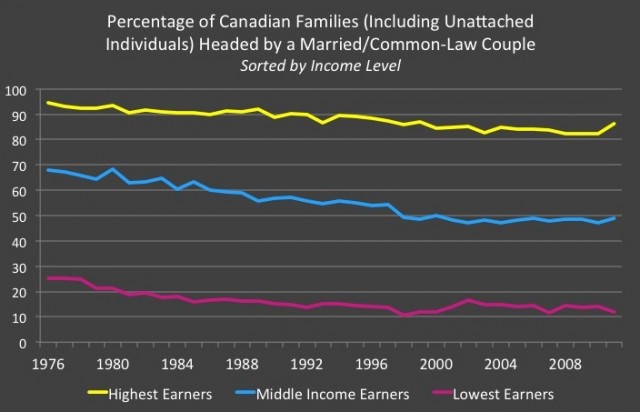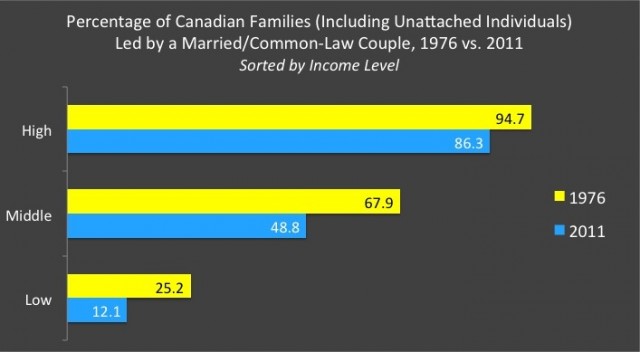Highlights
Canadian Federal Employment Minister Jason Kenney has been criticized for recently making what should be an unremarkable observation: that youth from stable families are more likely to be economically successful as adults. The comments were made in the context of a controversial family tax proposal, which almost certainly increased public scrutiny of the statements.
No doubt the brief flare-up was political in nature, but it illustrates the suspicion Canadians feel around the issue of family formation and well-being. While Americans acknowledge the trajectory of marriage decline moving further into the middle class, Canadian publications have seldom considered the link between marriage decline and economic status. Perhaps that’s due to the lack of data, or to levels of income inequality and social immobility that are less severe than those of our southern neighbors.
At the Institute of Marriage and Family Canada (IMFC), an Ottawa-based social policy think tank, we wanted to explore the relationship between marriage and income. Census data shows that marriage has declined for decades. We wondered if the decline occurred equally across income levels. Our recent report, The Marriage Gap between Rich and Poor Canadians, offers a big-picture examination of marriage and income.
The study found that in Canada, as in many other Western nations, there is a substantial link between marriage and income. The share of married and common-law families has not changed much among high earners over a thirty-five-year period, as the below charts show. Among middle- and lower-income families, however, the share of married and common-law families has declined more severely, falling by more than half among lower-income Canadians. Despite the significant drop in marriage share, particularly in the 1980s and 1990s, the decline began to show signs of leveling during the 2000s. And there was a small increase in marriage share among some age groups within the lower- and middle-earning groups over the last 13 years of the reference period.

Source: Statistics Canada’s Survey of Labour and Income Dynamics

Source: Statistics Canada’s Survey of Labour and Income Dynamics
Specifically, using special tabulations from Statistics Canada’s Survey of Labour and Income Dynamics for the years 1976 to 2011, we measured the share of families (including families of one unattached individual) where the reference person reported having a married or common-law spouse. We refer to this as the marriage share. Common-law and married families are bundled together within the data until after 1997. We consider this a limitation because of differences in relationship stability and economic behaviors, such as income pooling.
Our definitions of age and income groups are somewhat arbitrary. Respondents were aggregated into three income groups. The lowest income group includes those families and unattached individuals whose income is, at most, 25 percent less than the median. The middle-income group, which we consider a proxy for the middle class, has income within 25 percent of the median. The top income group includes family units whose income was at least 25 percent above the median. We also created three age groups: under 35 years of age, those aged 35 to 54 years, and those 55 years old and over.
The marriage gap between rich and poor existed prior to 1976 but has grown since that time.
The main finding suggests that the marriage gap between rich and poor existed prior to 1976 but has grown since that time. Two other findings caught our interest.
First, income was more likely to predict marital status than age was: the rich-poor marriage gap persists among Canadians of all ages.
Second, a small, recent increase in marriage share was detected among some age groups within the lower- and middle-income earners. The gains occurred within the final 13 years of the reference period and were due more to increases in formal marriage than in common-law marriage. The one exception was among lower income earners under age 35, for whom common-law relationships account for the majority of the gain in marriage share. In the same young age group at all income levels, the marriage share posted a small decline coinciding with the 2008 recession.
These trends matter because healthy marriages benefit families and society. Married families tend to build more wealth and are less susceptible to poverty. Children from stably married families have an increased likelihood of achieving upward economic mobility as adults. Wealthier Canadians are more likely to access the economic benefits of marriage, but these benefits need not be reserved for high earners alone. Our hope for the project is to shed light on the relationship between marriage and income in Canada and to encourage further research and conversations among people of various perspectives on this issue.
Peter Jon Mitchell is a Senior Researcher at the Institute of Marriage and Family Canada.















